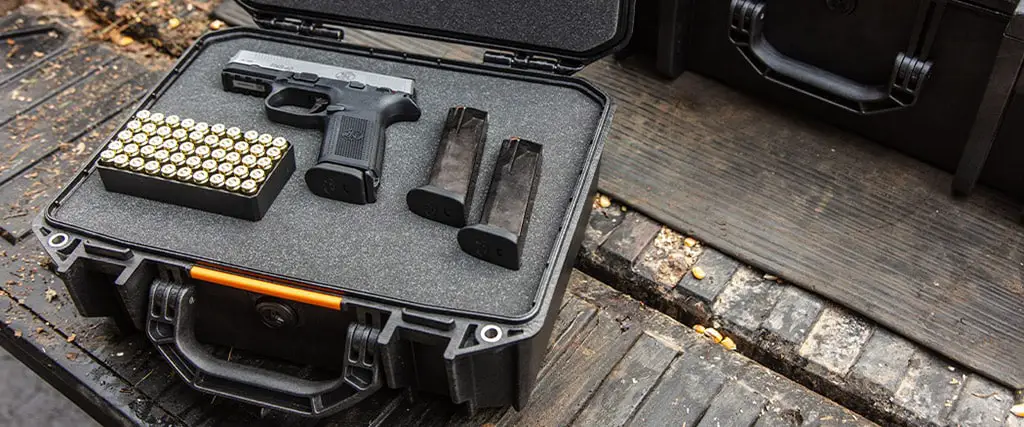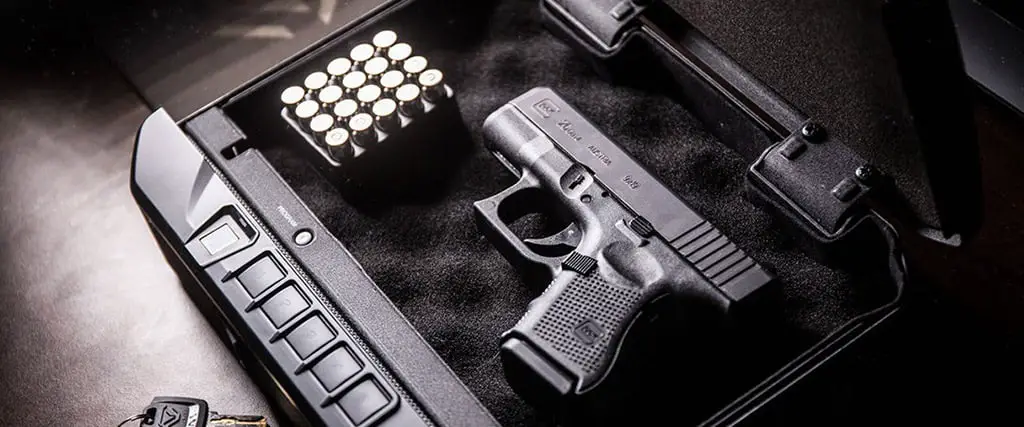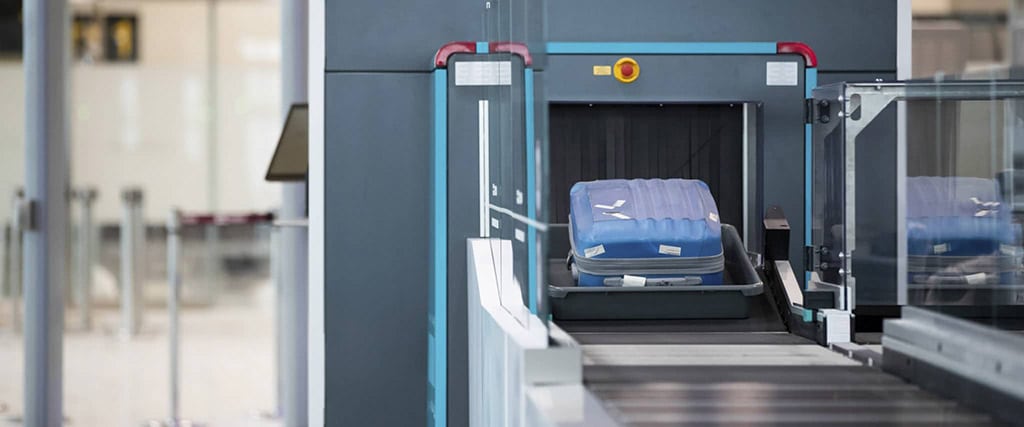A lot of people are afraid of bringing their firearms when they fly, and that’s not surprising. The regulations are confusing and overwhelming, particularly for those new to traveling with weapons.
If you travel a lot, it helps to learn the legal aspects of flying with a firearm for a hassle-free and worry-free trip. This guide aims to help you with that.

The TSA Firearm Regulations
The TSA’s regulations for transporting firearms states that:
“You may transport unloaded firearms in a locked hard-sided container as checked baggage only. Declare the firearm and/or ammunition to the airline when checking your bag at the ticket counter. The container must completely secure the firearm from being accessed. Locked cases that can be easily opened are not permitted. Be aware that the container the firearm was in when purchased may not adequately secure the firearm when it is transported in checked baggage.“
Upon interpreting this policy, it means that if you plan to travel and bring firearms and ammunition, you need to place your guns inside a locked hard-sided container where you can place a lock for added security.
If the locked hard-sided container you’re using to secure your firearm in is compact enough to be placed inside a larger, soft-sided checked bag, just be sure you declare it at the ticket counter.
Also, other than rifle scopes, it is vital to remember that ANY firearm parts is prohibited in carry-on bags and needs to be checked by the proper airline authorities.
Even though it’s a bit unclear whether you need to declare inert training aids, like airsoft guns, firearm replicas, SIRT pistols, or Blueguns at check-in, the best thing to do is check with your airline company.
Take note that the TSA also has very particular guidelines when it comes to flying with any type of defensive sprays. You are prohibited from carrying sprays with you other than in checked bags.
To make matters even more confusing, different airlines may have their own specific guidelines, procedures, and limitations to follow in addition to federal TSA regulations.
To get around this, the best thing you can do is familiarize yourself with TSA regulations and read up on your airlines’ policies if you plan to transport unloaded firearms.
Why Are TSA Firearm Regulations Are Important?

Owning a gun is a great privilege with the greater responsibility of handling, transporting, and using it safely and properly.
Over the years, gun safety has been a concern for most people. The government has drafted several different rules and regulations towards owning, carrying, and transporting firearms.
Whether you’re carrying it for safety purposes or you’re heading to your next hunting trip, there are important laws you need to be aware of when transporting your firearms.
This fact is especially true when you’re transporting firearms. These guidelines may initially seem quite strict, but they are made to keep you and your fellow passengers safe in your flight.
Penalties You May Incur
Making mistakes when you fly with firearms can cost you a lot of money. In addition, you could face both criminal and civil charges.
“… local and state governments, and other countries, may have their own rules on firearm possession or transportation. As a result, prohibited items may result in both a TSA civil enforcement action and a criminal enforcement action.”
What’s more, the TSA “may impose civil penalties of up to $13,910 per violation per person,” and repeat violations would result in higher fines. Circumstantially, it seems that quite a few of these instances are left in the hands of the responding law enforcement officer and TSA investigators.
Tips To Make Flying With A Firearm Smoother and Easier
Get to Know in Advance the Laws of Your Destination
Before you even consider packing up your guns for travel, it is important to make sure the unloaded firearms you’re planning on taking with you are legal at your destination.
This process entails that you need to check if the firearms you’re bringing are allowed. You also need to ensure that your firearm magazines are of legal capacity to ensure that you are complying with the state you’re planning to visit.
Other things to note are the open carry or concealed carry laws, how to legally store/transport your firearms in vehicles if you don’t have a permit, what permits are required or recognized, and the big ones.
Pack Your Gun at Home
Like how you pack your belongings in your travel bag or suitcase and do a checklist before your trip, you should do the exact same for your unloaded firearm, firearm magazines, and other related gear.
Also, remember to unload your firearm completely. That includes removing any ammunition in the chamber (or cylinder) and emptying your magazines.
You must do this process at home where you can utilize the privacy of your home space and a safe environment where you can be in control.

Any firearms, firearm magazines, loose ammunition, and other gear should be properly secured and stored properly inside a locked case.
Going to the airport, parking your vehicle, and getting inside with all your luggage can be a challenging affair all on their own; trying to ensure your firearm is properly packed in that mix is unnecessary stress and can be unsafe for you and other people around you.
Use a Locked Hard Sided Container to Store Your Guns
According to TSA guidelines, your firearms should be unloaded. They can be placed inside a secure case with integrated combination locks or a case with at least two holes meant for heavy-duty locks (padlocks with keys or combination locks).
Upon taking these measures, you can store your pistol cases inside your checked luggage.
There are some instances where people get by by using the plastic case provided by the gun manufacturer.
However, for cases like this, it’s better to follow the TSA regulations and get the proper case to meet the durability requirements and save you from unnecessary hassles. They are fit for travel, up to regulation, and the big ones come with wheels for ease and convenience.
Weigh Your Gun Case and Ammunition
Staying at the 50-lb limit imposed by most airlines might mean sacrificing other items in your inventory or checking in a second bag altogether. Most airlines will allow you to carry up to 11lbs of ammunition packed in your suitcase. However, they prefer it in the original packaging.
If you have your ammo in bulk or reload it, it is necessary to store it in a safe, lockable container or plastic ammo box. Those flimsy resealable plastic bags won’t do at all.
Use Appropriate Locks When Securing Your Gun Case and Ammo Containers
You may be thinking of using TSA-recognized locks on your locked cases because you want to adhere to their regulations as much as possible. And what better way to do it than using a TSA lock? But did you know this is a bad idea?
It is prohibited by law to use TSA locks on your hard-sided container.
The reasoning behind this is that unauthorized people could gain access to your firearms once your hard-sided container has been inspected. According to the law, only the passenger must maintain possession of the key or combination code necessary to open their gun case.
Even though they are TSA employees, they should not have access to your hard-sided container once it is cleared, without you being present to unlock the case yourself.
Upon having your gun inspected, ensuring it is completely secure in your case, and placed inside your luggage, you can place TSA locks on your luggage zipper pulls, but not on the firearm case!
Double-Check TSA and Your Airline’s Rules and Policies
Different airline employees and TSA agents have various understandings of the TSA’s firearm regulations. It’s better to prepare a printed copy or a screenshot on your phone of these regulations to avoid any issues and ensure compliance.
That way, you have something to back you up if you have to verify or prove that you’re following the rules.
Even though similar standards have usually been set across airline companies, variations could exist between their policies so having a copy of their policy page is great just in case.
Finally, while ticketing agents are well-versed in various information, it’s important to remember that not every agent is familiar with firearm guidelines and policies, especially if they aren’t used to dealing with them.
Stay With Your Bag Through Screening

After the TSA agent has finished inspecting your belongings, they will put your luggage in line to be scanned by security scanners. Just because the TSA has finished inspecting your bags doesn’t mean you should rush ahead.
You may not be clear to go yet, and the TSA may need you for other reasons during the scanning process.
Additionally, being fully aware that you have a deadly weapon in your luggage, you need to make sure that you are aware of your belongings at all times. Stay with your bag, focus on it, and ensure it gets through the scanner.
Document Everything
It may seem overkill, but proper documentation can save you a lot of trouble when flying with a firearm. If you print airline, airport, and TSA policies in advance, you have reference material to fall back to when you need to prove you’re observing proper regulations.
Taking pictures of your gun, case, and your luggage lets you have peace of mind that your belongings are safe, secured, and haven’t been tampered with.
Upon noticing that your luggage looks wrong when you pick it up at the baggage carousel, you should take pictures as evidence before opening it.
That way, if something does go wrong, you can show this proof to the proper authorities, ensure compliance, and help with their investigation.
